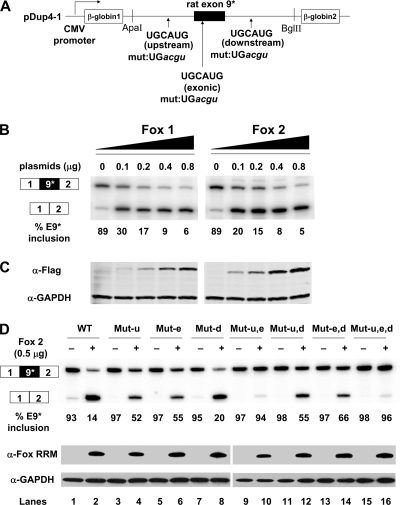FIG. 5.
Fox1 and Fox2 proteins repress exon 9* splicing in Dup-E9* minigene transcripts expressed in HEK293T cells. (A) Diagram of Dup-E9* minigene shows the positions of three Fox binding elements. The Dup-E9* minigene contains 927 nucleotides of rat genomic sequence including 205 nucleotides of upstream intron, the 75-nucleotide exon and 647 nucleotides of downstream intron (see Fig. S3A in the supplemental material). (B) Primer extension assay of exon 9* splicing in HEK293T cells cotransfected with Dup-E9* and increasing amounts of Fox1 and Fox2 plasmids. (C) Western blot of tagged Fox1 or Fox2 expression in transfected HEK293T cells. (D) Mutation of Fox binding elements in the exon 9* minigene abolishes the Fox2 repressive effect on splicing. WT, Dup-E9* minigene without mutations in Fox-binding element. Mut-u, Mut-e, and Mut-d indicate mutations (UGCAUG→ UGacgu) in the upstream (u), exonic (e), or downstream (d) Fox binding elements, respectively. These were combined in Mut-u,e, Mut-u,d, Mut-e,d, and Mut-u,e,d. Minigene reporters were cotransfected with 0.5 μg of empty vector pCDNA3.1+ (−) or Fox2 expression vector (+). Immunoblot assay of Fox2 expression in the transfected cells using anti-Fox RRM antibody is shown at the bottom. α, anti.

